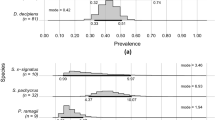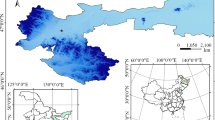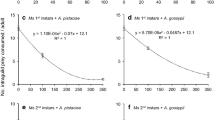Summary
All stages of Bledius spectabilis Kratz (Staphylinidae) dig wine-bottle shaped burrows in the intertidal Salicornia zone. The adult female lays her eggs around her burrow and, by remaining with them, prevents both flooding by the tide and anoxia. Flooding is prevented by an ‘ever-ready’ burrow which exploits a surface tension effect and by blocking the burrow once the tide comes in. The burrow has a narrow neck (about 2 mm in diameter) leading to a living chamber 5 mm in diameter. Tides over artificial tubes in agar showed that a critical minimum neck diameter of 2–3 mm prevented sudden flooding, giving time to block the neck with mud. Blocking took about four minutes. Ensuring the burrow is reopened at each low tide is a vital role of the brooding female in anaerobic or impermeable soils. Field models of burrows became anoxic in 4 days, much less than the 4 week long egg stage. A lab model system with anaerobic agar and calculations of oxygen uptake and diffusion supported this conclusion. Mortality of orphaned larvae may be much lower, however, in burrows within large Bledius aggregations because of mitigating good drainage and soil aeration: larval mortality from physical causes in these burrows did not increase over 3 weeks but without the mother, 14% of the eggs were attacked by mould, and two burrows were taken over by a predatory carabid, Dichierotrichus gustavi, and all larvae eaten. The surface tension effects of small air-filled openings may be used by small air-breathing animals in many intertidal habitats. Like Bledius, other intertidal animals, including large ones, may block their burrows at high tide to keep them full of air. Maternal care, in particular the combination of behaviours which protect the brood from the tide and anoxia, enables this airbreathing insect to colonise the inhospitable habitat of the intertidal saltmarsh.
Similar content being viewed by others
References
Anon (1978) Information about electrical electronic materials, Sylgard 182 and 184 silicone elastomers. Dow Corning, Reading. Tech Bull 61-113A-01
Armstrong W (1979) Aeration in higher plants. Adv Bot Res 7:226–332
Beeftink WG (1977) The coastal marshes of Western and Northern Europe: an ecological and phytosociological approach. In: Chapman VJ (ed) Wet coastal ecosystems. Elsevier, Amsterdam, pp 109–156
Bretherton FP (1961) The motion of long bubbles in tubes. J Fluid Mech 10:166–188
Chapman VJ (1960) The plant ecology of Scolt Head Island. In: Steers JA (ed) Scolt Head Island. 2nd edn. Heffers, Cambridge, pp 85–163
Christy JH (1982) Burrow structure and use in the sand fiddler crab, Uca pugilator (Bosc.). Anim Behav 30:687–694
Christy JH (1983) Female choice in the resource-defense mating system of the sand fiddler crab, Uca pugilator. Behav Ecol Sociobiol 12:169–180
Clarke ROS (1973) Coleoptera: Heteroceridae. Handbooks for the Identification of British Insects. R Entomol Soc, Lond v 2 (c)
Eickwort GC (1981) Presocial insects. In: Hermann HR (ed) Social insects, vol 2. Academic Press, New York, pp 191–280
Ellington CP (1984) The aerodynamics of hovering insect flight. III Kinematics. Philos Trans R Soc London [B] 305:41–78
Evans HE (1977) Extrinsic and intrinsic factors in the evolution of insect sociality. Bio Sci 27:613–617
Evans PD, Ruscoe CNE, Treherne JE (1971) Observations on the biology and submergence behaviour of some littoral beetles. J Mar Biol Assoc UK 51:375–386
Foster WA, Treherne JE (1975) The distribution of an intertidal aphid, Pemphigus trehernei Foster, on marine saltmarshes. Oecologia 21:141–155
Foster WA, Treherne JE (1976) The effects of tidal submergence on an intertidal aphid, Pemphigus trehernei Foster. J Anim Ecol 45:291–301
Foster WA, Treherne JE (1978) Dispersal mechanisms in an intertidal aphid. J Anim Ecol 47:205–217
Foster WA, Wyatt TD (1985) Recent research on the ecology of saltmarsh insects in the United Kingdom. Verhandlungen der Gesellschaft für Ökologie (Bremen 1983) Band XIII 1985:81–84
Hargrave BT (1969) Similarity of oxygen uptake by benthic communities. Limnol Oceanogr 14:807–809
Kensler CB (1964) The crevice habitat on Anglesey. J Anim Ecol 33:200–202
Larsen EB (1936) Biologische Studien über die tunnelgrabenden Käfer auf Skallingen. Vidansk Meed Fra Dansk Naturh Foren Kobenhavn 100:1–232
Larsen EB (1952) On sub-social beetles from the saltmarsh, their care of progeny and adaptation to salt and tide. Trans Ninth Int Cong Ent, vol 1:502–506
Staddon BW (1972) On the suggestion that the secretion from the metathoracic glands of a surface-dwelling aquatic insect, Gerris naja (De Geer), (Heteroptera: Gerridae) has a waterproofing function. J Exp Biol 57:765–769
Tallamy DW, Denno RF (1981) Maternal care in Gargaphia solani (Hemiptera: Tingidae). Anim Behav 29:771–778
Teal JM (1959) Respiration of crabs in Georgia saltmarshes and its relation to their ecology. Physiol Zool 32:1–14
Teal JM, Kanwisher J (1961) Gas exchange in a Georgia saltmarsh. Limnol Oceanogr 6:388–399
Vogel S (1981) Behavior and the physical world of an animal. In: Bateson PPG, Klopfer PM (eds) Perspectives in Ethology, vol 4, Plenum, New York, pp 179–198
Wilson EO (1971) The insect societies. Belknap Press, Cambridge, Massachusetts
Wilson EO (1975) Sociobiology—the new synthesis. Belknap Press, Cambridge, Massachusetts
Van Wingerden WKRE, Littel A, Boomsma JJ (1981) Strategies and population dynamics of arthropod species from coastal plains and green beaches. In: Smit CJ, Den Hollander J, van Wingerden WKRE, Wolff WJ (eds) Final Report of the section ‘Terrestrial Fauna’ of the Wadden Sea Working Group 10, Steun aan Waddenonderzoek, Leiden
Withers PC (1978) Models of diffusion-mediated gas exchange in animal burrows. Am Nat 112:1101–1112
Wyatt TD (1984) The ecology of parental care in the subsocial saltmarsh beetle, Bledius spectabilis. Ph D Thesis. University of Cambridge
Yensen N, Yensen E, Yensen D (1980) Intertidal ants from the Gulf of California, Mexico. Ann Entomol Soc Am 73:266–269
Author information
Authors and Affiliations
Rights and permissions
About this article
Cite this article
Wyatt, T.D. How a subsocial intertidal beetle, Bledius spectabilis, prevents flooding and anoxia in its burrow. Behav Ecol Sociobiol 19, 323–331 (1986). https://doi.org/10.1007/BF00295705
Received:
Accepted:
Issue Date:
DOI: https://doi.org/10.1007/BF00295705




